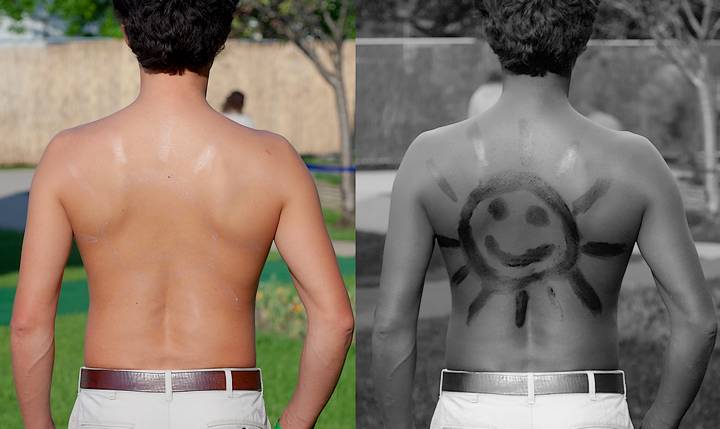 A smiling sun painted in sunscreen, shown under normal and UV light. The message clear, good sunscreen is effective.
A smiling sun painted in sunscreen, shown under normal and UV light. The message clear, good sunscreen is effective.
Children’s skin is a little more vulnerable and getting them coated with sunscreen can be a task, amidst an excited arrival at a pool, the beach, or park. Those points apart, the principles for children and adults are similar.
Over 85% of the UK population appreciate that sun awareness messages apply to them. Even so, a survey by the British Association of Dermatologists suggests contradictory behaviour.
One in three people have been sunburnt during the last year, rising to about half of those who ventured overseas. Whilst achieving a lasting, even tan is best achieved without sunburn, this is often seen as “part of getting a tan”.
Sunbathers are more likely to use sunscreen than a few years ago, although a proportion make changes as part of tan management. Following the belief they should reduce use, or protection factor levels as they tan, to achieve a darker colour.
We all like to look good, not least young people and the thinking is understandable but misses the point on why sunscreen is important. Neither does being tanned protect you
How Sunscreen Works
The sun sends two types of radiation through our atmosphere:
- Ultraviolet A (UVA) – A factor in skin ageing, pigmentation problems and skin cancer, quite separate from tanning.
- Ultraviolet B (UVB) – The rays which burn your skin and can again cause damage, including types of skin cancer.
An SPF factor on sunscreen indicates protection levels from UVB. SPF 15 will allow one fifteenth of UVB rays through, SPF 30 one thirtieth, SPF 50 one fiftieth. The difference between letting 7% and 2% through may seem small but matters over time.
There are however limits on how far claims will help. In some countries, you will see factors of 80, or 100 but EU guidance limits claims to 50+. there is no such thing as 100% protection and looking to “improve” on 98% is as much marketing as reality.
The UVA star system (0 to 5) is not as definitive. This shows the proportion of UVA radiation absorbed by the sunscreen in comparison to UVB, regardless of how good the UVB protection is. A low SPF factor sunscreen could have a high level of stars, without providing good UVA protection.
Choosing a product which protects well against both variants makes sense. Sunscreen with an SPF of at least 30 and a UVA rating of 4 or 5 stars should provide this, although there are further factors to bear in mind.
Real World Use
None of us apply sunscreen perfectly, areas will be missed whether self applied, or a parent helping a child. They will benefit from further application, sunscreen will also wash off, rub off, or vanish in sweat, neither do we tend to apply as much as we should.
Expert studies and opinions across the globe share similar conclusions, sunscreen should be reapplied at least every two hours. This is regardless of “extended wear” or “once a day” marketing claims, there may be differences but the risks are too high.
On a similar theme, whilst sunscreen is important, wearing suitable clothing and finding shade when the sun is strongest will help. A combined approach to help prevent a condition which is growing rapidly, yet is substantially avoidable.
If you have any questions about skin cancer screening, or prevention for adults and children, please get in touch. Our staff are specialists in skin cancer but never happier than when not needing to treat people.
You may find the options below useful:
- Back to the home page for: Paediatric Dermatology.
- See options for children’s: Skin Cancer Screening.
- Read more background on: Childhood Dermatitis.
For any advice, or to arrange a dermatology appointment, call 020 8441 1043, or send an email via the Make An Appointment button below.
